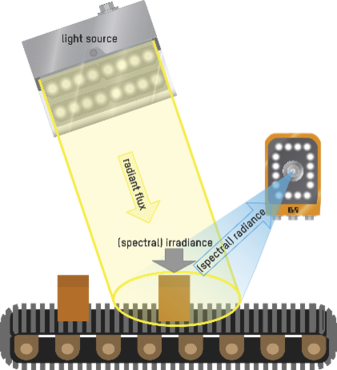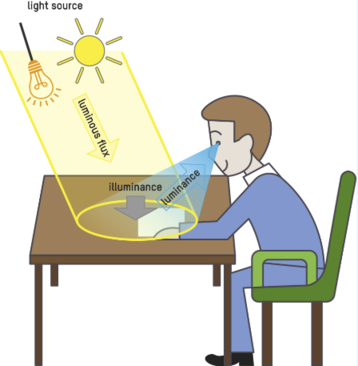光度学涉及测量人类可见光(即有限的波长范围),而辐射度学则涉及测量电磁辐射的光谱。这意味着辐射测量将光度测量扩展到更宽的波长范围,例如红外线或紫外线。
辐射源、辐照物体和测量仪器的特性是通过一系列辐射量来描述的,然后再从中推导出相关的光度量。下表列出的物理量的辐射特性和光度特性之间的区别在于,辐射量是乘以 CIE 光度函数(人类观察者的波长光谱范围为 380 至 780 纳米)。
这就意味着,光度量只是基于有限光谱的加权量,是更广泛的辐射度量范围内的一个特例!
单位 |
说明 |
相应的光度量 |
单位 |
说明 |
|
|---|---|---|---|---|---|
辐射功率(辐射通量) |
W |
单位时间内的辐射能 |
光通量 |
流明(lm) |
光源的辐射功率,用光度函数加权 |
辐射强度 |
瓦/秒 |
每个实角的辐射通量 |
发光强度 |
坎德拉 (cd) SI 基本单位 |
每个实角的光通量。说明光源向特定方向照射的强度。 |
辐照度 |
瓦/平方米 |
单位表面实际接收到的辐射通量。 |
照度 |
勒克斯(lx) lx = lm/m² |
单位照明表面的光通量。说明表面被照亮的强度。 |
辐射 |
瓦*米-2*秒-1 |
单位发光表面每个实角的辐射通量。 |
亮度 |
cd/m² |
光源相对于其投射表面(垂直于观察方向)的发光强度。人类将这一数值视为发光表面的亮度。 |
|
|||||
Photometry is concerned with measuring light that is visible to humans (that is, a restricted range of wavelengths), whereas radiometry is involved in measuring the spectrum of electromagnetic radiation. This means that radiometry expands photometry over wider wavelength ranges, to infrared or ultraviolet light for example.
The properties of radiation sources, irradiated objects and measurement instruments are described using a range of radiometric quantities, from which the associated photometric quantities are then deduced. The difference between the radiometric and photometric characteristics of the physical quantities listed in the table below is that radiometric quantities are multiplied by the CIE photopic luminosity function (within the range of the wave length spectrum of 380 to 780 nm for the human viewer).
This means that photometric quantities are only weighted quantities based on a limited spectrum that constitutes a special case within the broader range of radiometric quantities!
Unit |
Description |
Corresponding photometric quantity |
Unit |
Description |
|
|---|---|---|---|---|---|
Radiant power (radiant flux) |
W |
Radiant energy per unit time |
Luminous flux |
Lumen (lm) |
Radiant power from a light source, weighted by the luminosity function |
Radiant intensity |
W/sr |
Radiant flux per solid angle |
Luminous intensity |
Candela (cd) SI base unit |
Luminous flux per solid angle. Specifies how intensely a light source shines in a particular direction. |
Irradiance |
W/m² |
Radiant flux actually received per unit of surface. |
Illuminance |
Lux (lx) lx = lm/m² |
Luminous flux per unit of illuminated surface. Specifies how intensely a surface is illuminated. |
Radiance |
W*m-2*sr-1 |
Radiant flux per solid angle per unit of light-emitting surface. |
Luminance |
cd/m² |
Luminous intensity of a light source in relation to the surface that it is projecting onto (perpendicular to the viewing direction). Humans perceive this quantity as the brightness of a light-emitting surface. |
|
|||||

